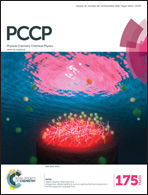Diffusion-controlled alteration of inhomogeneous materials: tailoring of the spatial distribution of nanoparticles in nanocomposites
Abstract
Gaining control over the spatial distribution of nanoparticles in composite polymer materials is a relevant goal for a range of nanotechnology applications. Promising methods to produce nanoparticles directly in the polymer matrix rely on their self-assembly from the atoms that are generated due to the photodestruction of the precursor additive. Such materials are known as photoinduced nanocomposites. In this work, we theoretically study the possibility of producing tailored nanoparticle distributions in such materials by the local modification of their physical properties. For instance, laser irradiation may cause a permanent free-volume expansion (laser swelling), which results in a substantial change in the diffusivity of the aggregating atoms. The modeling shows that the nanoparticles tend to accumulate in the domains where the diffusivity is greater. Additionally, the variation of the matrix properties may result in spatial modulation of the atom–matrix interaction energy and thus modulation of the atom solubility in the matrix. This phenomenon can also affect the NP spatial distribution. This paper formulates the problem of the precipitation phase transition from the supersaturated solution in a polymer solvent which is “frozen” in the spatially nonuniform state. The basic traits of this phenomenon are studied by means of an analytical model. Then the NP growth is simulated using a lattice model.



 Please wait while we load your content...
Please wait while we load your content...